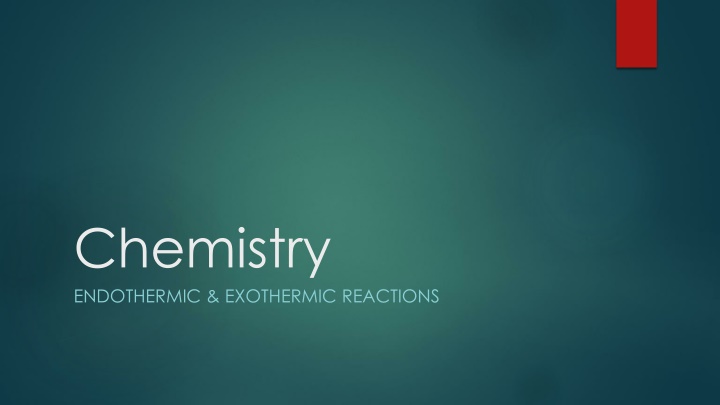
Chemistry: Reactants, Reactions, and Energy
Explore the concepts of endothermic and exothermic reactions, collision theory, activation energy, and specific examples of chemical reactions. Engage in hands-on activities to observe and identify reaction types, and enhance learning through computer simulations.
Download Presentation

Please find below an Image/Link to download the presentation.
The content on the website is provided AS IS for your information and personal use only. It may not be sold, licensed, or shared on other websites without obtaining consent from the author. If you encounter any issues during the download, it is possible that the publisher has removed the file from their server.
You are allowed to download the files provided on this website for personal or commercial use, subject to the condition that they are used lawfully. All files are the property of their respective owners.
The content on the website is provided AS IS for your information and personal use only. It may not be sold, licensed, or shared on other websites without obtaining consent from the author.
E N D
Presentation Transcript
Chemistry ENDOTHERMIC & EXOTHERMIC REACTIONS
Collision Theory Reactants in chemical reaction come together to form products. CO2+ NO CO + NO2 (Reactants) (Products) Atoms. Ions & Molecules must collide in order to react. They must collide in the correct orientation They must collide with sufficient energy to form the activation Complex.
Activation Energy & Reactions In order for a chemical reaction to take place, even it has a favorable orientation of the molecules, if there is not enough energy, the activation complex can not form. Analogy: Pushing a cart up a hill, have to have enough energy to get it to the top. Refrigerator cools and decreased the chemical reactions of decomposition of food Stove & Oven heat and increase the rate of chemical reaction to cook the food.
Endothermic Reactions CO2 + NO CO + NO2 6CO2 + 6 H2O 6O2 + C6H12O6
Exothermic Reactions CO + NO2 CO2 + NO 6O2 + C6H12O6 + energy (heat) 6CO2 + 6 H2O
Endothermic & Exothermic Reactions Activity: Your Turn Is it and endothermic or exothermic reaction? Materials: Get a partner Flask Balloon Sugar cube 20 ml warm water Procedure: In your Flask: Combine the 20 ml H2O, 1 sugar cube, 1 tsp yeast Place the balloon on the flask Swirl the flask Data: What is happening? What do your feel on the bottom of the flask? What type of reaction is it?
Activity #2 More Fun After Cleaning up your previous mess from Activity #1, get a model kit. In this model kit identify what color balls represent what atoms. Make any of the following molecules with your kit: CO2, H20, CH4, NO, NO2, N2
Computer Simulation Activity Google.com pHET - Chemistry Practice running each of the 3 simulations: States of Matter Chemical Equations Balloons & Buoyancy Gas Properties Take notes on what you learned for each one.
Adult Ed Project Endothermic & Exothermic Reactions .50 Credits The world around us is a constant state of Chemical Reactions. Whether we are eating, or planting a garden, thousands of chemical reactions are happening. Two such examples are: Photosynthesis and Cellular Respiration On a piece of paper Title the top with each of the two examples. (2 pieces of paper) Under the Title give a definition of what each is. Write an example of each and explain how it happens. (Research) Write the Chemical Equation for each. Explain each reaction as Endothermic or Exothermic and why. Draw the appropriate graph for that reaction labeling the Activation Energy, Reactants and Products, and the change in heat energy.
Works Cited Chemistry in the Community, p. 240 - 260, 2006, W.H. Freeman Co. Chemistry Matter & Change, p. 530 540, 2005, McGraw Hill, Glencoe
